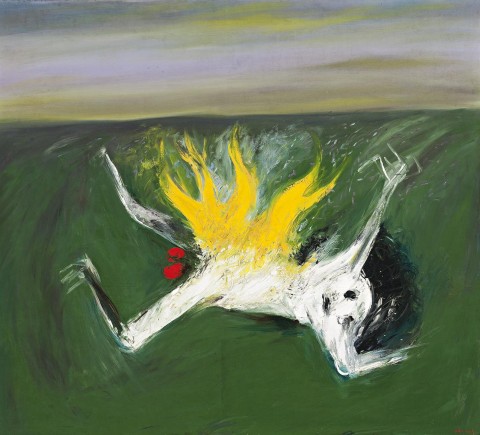NEBUCHADNEZZAR ON FIRE IN A GREEN LANDSCAPE (NO. 2), 1969
ARTHUR BOYD
oil on canvas
159.0 x 177.0 cm
signed lower right: Arthur Boyd
bears inscription verso: 47
Richard Demarco Gallery, Edinburgh, Scotland
Joseph Brown Gallery, Melbourne
Philip Bacon Gallery, Brisbane
Private collection, Melbourne
Christie’s, Melbourne, 1 May 2000, lot 168
Savill Galleries, Melbourne (label attached verso)
Private collection, Melbourne
Private collection, Sydney
Retrospective Exhibition of Paintings, Drawings and Other Works by Arthur Boyd, Richard Demarco Gallery, Edinburgh, Scotland, 14 April – 10 May 1969, cat. 47 (illus. in exhibition catalogue, pl. 11)
Nebuchadnezzar on fire fallen in a field, c.1966, oil on canvas, 114.7 x 109.6 cm, illus. in Boase, T. S. R., Nebuchadnezzar, Thames and Hudson, London, 1972, pl. 5, p. 25
In 1985, the academic Grazia Gunn curated an exhibition on the ‘seven persistent images’ she identified as running continuously through the art of Arthur Boyd.1 In the associated catalogue, she made the penetrating observation that ‘(s)tarting from the premise of man as victim, Boyd makes human suffering the central subject and continuous underlying theme of his work’.2 With the Old Testament figure of Nebuchadnezzar, the artist found a perfect vehicle for a charged series of paintings and drawings that explored the possibility of redemption following exile and disgrace.
The flawed heroes of the Bible had long held fascination for Boyd, who first heard their tales read aloud by his grandmothers ‘from an illustrated bible, the tinted engravings in the text being as marvellous as they were bizarre, often even gruesome’.3 Many of his earlier paintings, sculptures and ceramics were inspired by these narratives, often depicted within an Australian setting. By the mid-1960s, the artist and his family were expatriates based in England and as a consequence of his growing reputation, Boyd was able to undertake collaborations with notable British specialists in various fields. One of these was Thomas S. R. Boase, a medieval scholar who had actually first met the artist in Australia in 1956, and with whom he had published a book on the life of St Francis of Assisi in 1968.4 Their next project was based on the Chaldean leader Nebuchadnezzar, who ruled from 604 to 561 BC, with his kingdom based in Babylon, a city of archaeological renown with its ziggurats, Ishtar Gate and hanging gardens. As recounted in the Book of Daniel, Nebuchadnezzar laid siege to Jerusalem and made slaves of the city’s Jews, and as his despotic power increased, so did his hubris until finally he went mad, and was driven out into the wilderness, eating ‘grass as oxen’, his hair ‘grown like eagle’s feathers, and his nails like birds’ claws’.5
A significant inspiration for Boyd’s artistic approach to the story was the watercolour by William Blake depicting Nebuchadnezzar on his knees, half-human, half-animal. He would have also studied Blake’s suite of watercolours depicting Dante’s The Divine Comedy, an artistic gem within the collection of the National Gallery of Victoria, Melbourne since 1920. Also entwined is the story of Icarus flying too close to the sun only to crash and burn, a subject Boyd depicted on ceramic tiles in the early 1950s. In Nebuchadnezzar on Fire in a Green Landscape (No. 2), 1969, the outcast king, like Icarus, is shown engulfed in flames, crawling pitifully within an acid-green field, a riveting yet pathetic figure desperately seeking sanctuary under an otherwise calm, crepuscular English sky. A further impetus for Boyd was the then-raging Vietnam War, a conflagration which had led to the horrific experience of protesters self-immolating on Hampstead Heath near the artist’s home. When twenty-seven paintings from the series were exhibited in Edinburgh in 1969, the accompanying catalogue text noted that ‘(Boyd’s) paintings encompass good and evil; things elemental and mysterious, and things intensely human and vulnerable’.6 Nebuchadnezzar on Fire in a Green Landscape (No. 2) is a powerful work from an equally powerful series, and related examples are now housed within major institutional collections including the National Gallery of Australia and the National Gallery of Victoria.
1. Gunn, G., Arthur Boyd: seven persistent images, Australian National Gallery, Canberra, 1985
2. Gunn, G., op cit., p. 23
3. Gunn, G., ‘Tribute. Arthur Boyd: 1920-1999’, Art and Australia, Sydney, vol. 37, no. 2, December 1999/January – February 2000, p. 207
4. Boase, T. H. S., St Francis of Assisi, Thames and Hudson, London, 1968
5. Book of Daniel: 4:33
6. Oliver, C., ‘A Welcome to Arthur Boyd’, Retrospective Exhibition of Paintings, Drawings and Other Works by Arthur Boyd, catalogue essay, Richard Demarco Gallery, Edinburgh, Scotland, 1969
ANDREW GAYNOR
